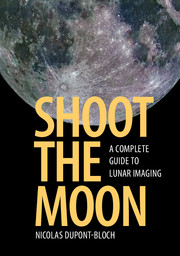Book contents
- Frontmatter
- Dedication
- Contents
- Preface
- 1 Introducing lunar imaging
- 2 Choosing your imaging equipment
- 3 Adapting your imaging device to the instrument
- 4 Tuning your telescope for lunar imaging
- 5 Wide-field lunar imaging
- 6 High-resolution lunar imaging
- 7 Essential image processing
- 8 Advanced image processing
- 9 Making 3D lunar images
- 10 Measuring and identifying lunar features
- 11 Photogenic features of the Moon
- 12 Naming, archiving, printing, and sharing lunar images
- Appendix 1 Maps of the Moon, the Lunar 100, and other targets
- Appendix 2 Webpages, books, and freeware for the Moon
- Appendix 3 Figure data
- Index
2 - Choosing your imaging equipment
Published online by Cambridge University Press: 05 September 2016
- Frontmatter
- Dedication
- Contents
- Preface
- 1 Introducing lunar imaging
- 2 Choosing your imaging equipment
- 3 Adapting your imaging device to the instrument
- 4 Tuning your telescope for lunar imaging
- 5 Wide-field lunar imaging
- 6 High-resolution lunar imaging
- 7 Essential image processing
- 8 Advanced image processing
- 9 Making 3D lunar images
- 10 Measuring and identifying lunar features
- 11 Photogenic features of the Moon
- 12 Naming, archiving, printing, and sharing lunar images
- Appendix 1 Maps of the Moon, the Lunar 100, and other targets
- Appendix 2 Webpages, books, and freeware for the Moon
- Appendix 3 Figure data
- Index
Summary
Shared, fundamental characteristics
Photolenses, refractors, and reflectors share two basic characteristics and a derived one.
• The focal length, or optical distance between the objective or the main mirror and the image sensor; this determines the size of the image. This is not the most important factor because this magnification can easily be increased or decreased as long as it is not excessive with respect to the diameter and the optical quality.
• The diameter of the objective or of the main mirror; this determines the resolving power (accuracy), the contrast, and the sensitivity to turbulence.
• The focal-length/diameter ratio, or F/D ratio, an important parameter for photography; it determines the exposure duration, the ease of focusing, and some geometrical characteristics which affect the image field.
A golden rule is that, when the focal length is large with respect to the diameter, optical flaws are minimized. As the diameter increases, the F/D ratio of an achromatic refractor has to increase if we are to maintain a comparable quality (e.g. from F/D = 8 for an 80-mm (3-in) achromatic refractor up to F/D = 15 for a 150-mm (6-in) achromatic refractor). Reflectors and apochromatic refractors are less affected. Furthermore, devices with “slow” optics (when the F/D ratio is more than 8 or so) are cheaper because they are easier to manufacture while maintaining the same – or better – optical quality, easier optical adjustment, and possibly a better ease of use even with a basic focuser. Lunar imaging, unlike most astrophotographical subjects, does not demand a “fast” (<6) F/D ratio.
Optical flaws
Chromatism and astigmatism affect the entire image. Other optical deformations affect mainly the corners of the image.
• Coma transforms points at the corners into little comet-like spots.
• Distortion either stretches the corners or inflates the center.
• Astigmatism transforms points into crosses when the image is focused, or vertical or horizontal lines when it is out of focus.
• Chromatism is the impossibility for the optics to make all colors converge at the same place. While the image is sharp in red, it is somewhat unfocused in blue. In addition, lenses suffering from chromatism also focus the blue poorly and waste light.
- Type
- Chapter
- Information
- Shoot the MoonA Complete Guide to Lunar Imaging, pp. 17 - 90Publisher: Cambridge University PressPrint publication year: 2016



